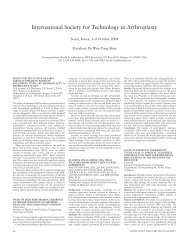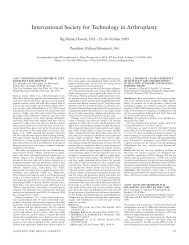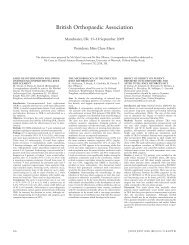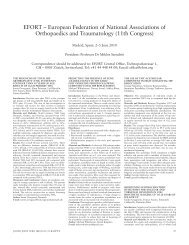Procs III 2011.indb - Journal of Bone & Joint Surgery, British Volume ...
Procs III 2011.indb - Journal of Bone & Joint Surgery, British Volume ...
Procs III 2011.indb - Journal of Bone & Joint Surgery, British Volume ...
You also want an ePaper? Increase the reach of your titles
YUMPU automatically turns print PDFs into web optimized ePapers that Google loves.
358 HELLENIC ASSOCIATION OF ORTHOPAEDIC SURGERY AND TRAUMATOLOGY<br />
an excellent or good result according to the Lysholm<br />
knee score. Four patients had a restriction <strong>of</strong> knee joint<br />
motion postoperatively, and an arthroscopic arthrolysis<br />
was performed in one <strong>of</strong> them. Analysis showed that,<br />
age, length <strong>of</strong> tear, simultaneous ACL reconstruction,<br />
chronicity <strong>of</strong> injury, and location <strong>of</strong> tear did not affect<br />
the clinical outcome. Conclusions: Our results, shows<br />
that arthroscopic meniscal repair with the FasT-Fix<br />
repair system provides a high rate <strong>of</strong> meniscus healing<br />
and <strong>of</strong>fers reduction <strong>of</strong> both the risk <strong>of</strong> serious neurovascular<br />
complications and operative time.<br />
112 AUGMENTATION OF FEMORAL<br />
FIXATION IN HAMSTRING ANTERIOR<br />
CRUCIATE LIGAMENT RECONSTRUCTION<br />
WITH A BIOABSORBABLE BEAD<br />
M. Iosifidis, I. Melas, G. Karnatzikos, N.<br />
Sakorafas, A. Kyriakidis<br />
2nd Orthopaedic <strong>Surgery</strong> Department,<br />
“Papageorgiou” General Hospital, Thessaloniki<br />
The bead EndoPearl is bioabsorbable material which<br />
placed in the ACL graft edge, and augment the stabilization<br />
in the femoral tunnel when an interference screw is<br />
used. Our aim was to recorded the operative characteristics<br />
<strong>of</strong> this technique and the clinical results after using<br />
EndoPearl in ACL reconstruction with hamstrings graft.<br />
In 36 <strong>of</strong> our patients who had ACL reconstruction<br />
with hamstrings we used EndoPearl bead. They were 23<br />
men and 13 women mean age 27.8 years (17-46). The<br />
graft was fi xed in the femur side with interference screw.<br />
All patients followed the same p.o. rehabilitation regime.<br />
We followed them up the 1st, 2nd, 3rd, 6th and 8th p.o.<br />
month. During the last follow-up we checked the anterior<br />
drawer test, Noulis-Lachman test and in some cases pivot<br />
shift test, and in parallel Lysholm score was recorded preoperatively<br />
and in the last examination.<br />
In this last F.U. check none <strong>of</strong> them had positive<br />
Noulis-Lachman test or pivot shift test. The anterior<br />
drawer test was negative to 32 patients and in 4 we<br />
found slight laxity in comparison with the health leg.<br />
Lysholm score showed signifi cant improvement (mean<br />
90.2 p.o.), and nobody had “giving way”.<br />
The application <strong>of</strong> the EndoPearl in conjunction with<br />
a bioscrew in the femoral tunnel in autogenous ACL<br />
reconstruction using semitendinosus and gracilis tendon<br />
grafts provides a signifi cantly decreased in p.o. laxity.<br />
113 DYNAMIC INVESTIGATION OF KNEE<br />
ROTATIONAL STABILITY FOLLOWING<br />
DOUBLE BUNDLE ACL RECONSTRUCTION<br />
A. Tsarouhas, M. Iosifidis, D. Kotzamitelos, I.<br />
Spyropoulos, C. Chrysanthou, I. Giakas<br />
Orthopaedic Department, Naoussa General<br />
Hospital, Greece; Department <strong>of</strong> Physical<br />
Education, University <strong>of</strong> Thessaly, Greece;<br />
Institute <strong>of</strong> Human Performance and<br />
Rehabilitation, Centre for Research and<br />
Technology <strong>of</strong> Thessaly, Trikala, Greece<br />
To evaluate in-vivo the effectiveness <strong>of</strong> the double<br />
bundle technique for Anterior Cruciate ligament (ACL)<br />
reconstruction in restoring knee rotational stability<br />
under varying dynamic loading conditions.<br />
The study group included 10 patients who underwent<br />
double-bundle ACL reconstruction with hamstrings<br />
tendon autograft, 12 patients with single-bundle reconstruction,<br />
10 ACL defi cient subjects and 12 healthy<br />
control individuals. Kinematic and kinetic data were collected<br />
using an 8-camera optoelectronic motion analysis<br />
system and one force plate. Knee rotational stability was<br />
examined during two maneuvers: a combined 60o pivoting<br />
turn and immediate stairs ascend and a combined<br />
stairs descend and immediate 60o pivoting maneuver.<br />
The two factors evaluated were the maximum<br />
There were no signifi cant differences in tibial rotation<br />
between the four groups in the examined maneuvers.<br />
Tibial rotation in the single- and the double-bundle<br />
groups were even lower than the control group. Rotational<br />
moments did not differ signifi cantly between the<br />
four groups in any <strong>of</strong> the examined maneuvers. In gen-<br />
eral, rotational moments in the affected side <strong>of</strong> the ACL<br />
reconstructed and defi cient groups were found reduced<br />
compared to the unaffected side.<br />
Double-bundle reconstruction does not reduce knee<br />
rotation further compared to the single-bundle technique<br />
during dynamic stability testing under varying<br />
conditions. The injured side <strong>of</strong> ACL reconstructed or<br />
defi cient individuals is exposed to substantially lower<br />
rotational moment compared to the intact side.<br />
114 TREATMENT OF ACUTE RUPTURES<br />
OF ACL WITH AN ACHILLES TENDON<br />
ALLOGRAFT<br />
N.E. Efstathopoulos, J. Sourlas, J. Lazarettos, V.<br />
Nikolaou, E. Brilakis, F.N. Xypnitos<br />
B’ Orthopaedic Department, Medical School,<br />
University <strong>of</strong> Athens<br />
To evaluate the clinical outcome <strong>of</strong> arthroscopic treatment<br />
<strong>of</strong> ACL with an Achilles tendon allograft in patient<br />
with acute rupture.<br />
22 patients, between 2003 and 2006, with acute<br />
rupture <strong>of</strong> ACL, were treated with an Achilles tendon<br />
allograft. The mean age was 26 years. Patients were evaluated<br />
before and after surgery and at the latest follow-up<br />
with Noulis-Lahmann test and Pivot shift test. We also<br />
used IKDC score, Lysholm score and one leg stance test<br />
and functional reach test. Patients were also evaluated<br />
with Cybex II + and with plain radiographies.<br />
The mean follow-up time was 3.5 years. 90% <strong>of</strong> the<br />
patients had a negative pivot shift test and 95% <strong>of</strong> the<br />
patients had a score at Noulis-Lahmann test +1. The<br />
mean value <strong>of</strong> IKDC score was 88 (62-100) and the<br />
mean time <strong>of</strong> Lysholm score was 91 (75-100). Until the<br />
latest follow-up there were no clinical sighs <strong>of</strong> infl ammation<br />
or graft rejection. Radiologic evaluation revealed<br />
no sign <strong>of</strong> tunnel enlargement.<br />
We believe that the use <strong>of</strong> a fresh-frozen allograft in the<br />
treatment <strong>of</strong> acute ACL ruptures is an effective procedure<br />
for the restoration <strong>of</strong> ligamentous stability <strong>of</strong> the knee.<br />
115 OVERUSE SYNDROMES IN YOUNG<br />
ATHLETES.<br />
N. Markeas, A. Constantopoulou, N. Marinos, C.<br />
Patrikareas, J. Glykokalamos, D. Pasparakis<br />
2nd Orthopaedic Department, Children’s Hospital<br />
<strong>of</strong> Athens “P. & A. Kyriakou”<br />
The aim <strong>of</strong> this retrospective study is to isolate the cases<br />
<strong>of</strong> “overuse syndromes” in young athletes in whom the<br />
initial diagnosis proved wrong.<br />
During six-year period 2002 – 2007, 28 young athletes<br />
(16 boys and 12 girls) aged 9.6 years (ranged from<br />
6.5 to 14 years), suffering an underlying disease that<br />
had initially attributed to “overuse syndromes”, were<br />
treated in our Department. In all <strong>of</strong> the cases the history<br />
was misleading and the clinical examination was<br />
precarious, while the x-ray examination proved to be<br />
unclear. The remaining imaging exams led fi nally to the<br />
correct diagnosis that was confi rmed in the operating<br />
room or via the biopsy.<br />
In 4 cases a slipped capital femoral epiphysis was<br />
ascertained. In other cases we verifi ed an osteochondritis<br />
dissecans <strong>of</strong> femoral condyle or talus (4), an osteoid<br />
osteoma (4), Perthes disease (3), osteochondromas<br />
(3), calcaneonavicular synchondrosis (3), hemangioma<br />
(2), discoid meniscus (1), herpes zoster along the sciatic<br />
nerve (1), aneurysmal cyst <strong>of</strong> fi bula (1), accessory<br />
navicular (1), and osteosarcoma <strong>of</strong> fi bula (1).<br />
Overuse syndromes in young athletes should be<br />
treated with skepticism because another more serious<br />
disease may be hidden behind the symptoms and clinical<br />
signs. The children and adolescents have a skeleton that<br />
grows constantly and develops a special pathogenesis<br />
and this fact must be always kept in mind <strong>of</strong> parents,<br />
trainers and therapists. The young subjects who expect<br />
to be integrated in the athletic family should be previously<br />
examined by Pediatrician and Pediatric Orthopedic<br />
Surgeon so that a congenital anomaly or an acquired<br />
disease will be diagnosed in time.<br />
116 LONGTERM OUTCOMES OF SURGICAL<br />
TREATMENT OF SUPRACONDYLAR<br />
HUMERAL FRACTURES IN CHILDREN.<br />
BAUMAN’S ANGLE RELEVANCE WITH<br />
COMPLICATIONS.<br />
V. Tsiampa, A. Hitzios, D. Topsis, Z.<br />
Zaharopoulos, I. Tsagias, C. Dimitriou<br />
General Hospital <strong>of</strong> Thessaloniki, Hippokration<br />
During the period 2004-2009, 35 children were admitted<br />
to the emergency department,(24 males:11females),aged<br />
3-14 years old,(MEAN 8,45years),with supracondylar<br />
humeral fractures (33 extension type and 2 fl exion type).<br />
All fractures were closed and result <strong>of</strong> sports injuries<br />
or games and were treated with closed reduction under<br />
general anesthesia and percutaneous k-w fi xation.<br />
The postoperative follow-up lasted from 6months to<br />
4 years. The Bauman’s angle was evaluated postoperatively<br />
on the operated and normal elbow and was 76,<br />
6 ±1° and 74, 7 ±0, 6°. According to Flynn’s criteria<br />
the functional outcome was excellent in 29 cases. In 6<br />
cases where the Bauman’s angle was greater than 10-15°<br />
there has been observed varus deformity (4cases), valgus<br />
deformity (1case), and fl exion defi cit (1case).<br />
The percutaneous k-w fi xation and preservation <strong>of</strong><br />
Bauman’s angle with carrying angle too, on supracondylar<br />
humeral fractures on children is a safe solution to<br />
avoid future complications.<br />
117 ELASTIC INTRAMEDULLARY NAILING<br />
FOR THE TREATMENT OF FOREARM<br />
FRACTURES IN CHILDREN<br />
J. Anastasopoulos, D. Petratos, E. Ballas, E.<br />
Morakis, G. Matsinos<br />
2nd Orthopaedic Department, “Aghia Sophia”<br />
Childrens’ Hospital, Athens, Greece<br />
To evaluate the effi cacy <strong>of</strong> elastic stable intramedullary<br />
nailing (ESIN) for the treatment <strong>of</strong> forearm fractures in<br />
children and adolescents.<br />
Between June 2002 and August 2007, 28 patients (19<br />
boys – 9 girls) with 28 forearm fractures were treated<br />
with ESIN in our department. The mean age was 12.88<br />
years (range 10.9-14.82). Both forearm bones were<br />
affected in all cases. 13 patients were treated by intramedullary<br />
splinting immediate after the accident whilst<br />
15 children were operated after failure <strong>of</strong> conservative<br />
treatment and fracture redisplacement. The radius was<br />
nailed in a retrograde fashion in all cases. On the other<br />
hand antegrade nailing <strong>of</strong> the ulna was performed in 18<br />
cases whilst retrograde nailing in 5 patients. In 8 cases<br />
closed reduction was possible whilst a small incision at<br />
the fracture site was necessary in 20 children. In all cases<br />
an above-elbow cast was applied for 5 – 6 weeks postoperatively.<br />
The healing process was determined on the<br />
basis <strong>of</strong> two-projection radiographs. At the latest followup<br />
elbow and forearm motion were also assessed.<br />
Mean follow-up was 16 months (range, 7 – 28). With<br />
the exception <strong>of</strong> one case all fractures healed within 9<br />
weeks. No case <strong>of</strong> infection, cross-union or non-union<br />
occurred. At the latest follow-up all children presented<br />
with complete restoration <strong>of</strong> elbow movement but three<br />
<strong>of</strong> them had a defi cit <strong>of</strong> pronation <strong>of</strong> 15-20 degrees. In<br />
those cases where an open reduction was required the<br />
results were the same as in other cases.<br />
Based on our results, retrograde, <strong>of</strong> both bones, nailing<br />
is recommended for the treatment <strong>of</strong> all displaced<br />
forearm fractures in children older than 7 years-old.<br />
Proper preoperative curving <strong>of</strong> the nails <strong>of</strong>fers increased<br />
stability maintaining the anatomic relation <strong>of</strong> the forearm<br />
bones.<br />
J BONE JOINT SURG [BR] 2011; 93-B:SUPP <strong>III</strong>








